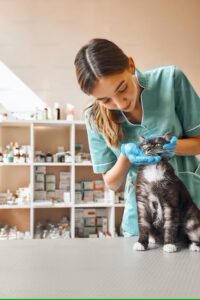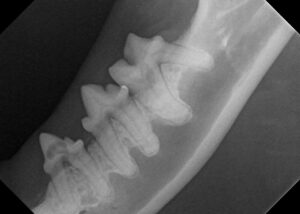
07 Sep Why Your Cat Also Needs Routine Dental Care
When we think about dental disease in our pets and four-legged family members, many of us immediately picture those small dogs with horrible bad breath. We have even coined the phrase “doggy breath.” Too often our feline friends are often left behind when it comes to their oral health care, not only in terms of prevention but also treatment. Utilizing our advanced technology, our team at Your Pet Dentist can help identify and treat cat oral health conditions and provide cat routine dental care.
Periodontal Disease in Cats
By the age of 3, approximately 70% of all cats will have some degree of periodontal disease. This can range from minor and localized gingivitis to severe and advanced periodontitis/bone loss and inflammation. Additionally, some cats will also develop progressive diseases such as caudal stomatitis and/or tooth resorption. Despite the severe pain that these conditions can create in affected cats, most cats remain asymptomatic until the disease process is significantly advanced. In fact, even to the well-trained eye, it is often possible to overlook early disease changes that can cause severe inflammation and pain.

Identifying Feline Oral Disease with Dental Radiographs
Even when oral disease is readily noticed via changes in eating habits, smells associated with the oral cavity, visible inflammation, etc, so much disease can remain hidden either under the gumline or just invisible to the naked eye (without magnification) during an awake oral examination. The amount of dental disease that can be missed without routine and thorough examinations has been evaluated time and time again. In fact, a major study published in the early 1990s evaluated the amount of oral disease that would be completely missed without dental radiographs (x-rays) and a sedated oral exam. This study showed that approximately 10% of tooth resorption would be missed, which can be completely devastating for a cat’s quality of life. Since tooth resorption in a cat is one of the most painful disease processes, we should be evaluating cats for this disease with routine frequency.

Radiographic image of tooth resorption on the left mandibular 3rd premolar in a cat (black spot on top of first tooth on the left)

Clinical image of hidden tooth resorption due to calculus (tartar) accumulation
Even when considering periodontal disease (disease associated with the teeth and supporting structures), it is impossible to determine the degree of disease present simply just by looking in the oral cavity. The stages of periodontal disease are classified via the degree of bone loss. Unfortunately, we have yet to meet a cat (or dog for that matter), that will allow us to properly probe each individual tooth on all surfaces to truly know just how much bone loss is present. Additionally, dental radiographs (x-rays) or cone-beam CT (specialized “CAT scan”) images are vital for full evaluation of the teeth within the oral cavity. Dr. Greenfield and I often joke that we wish we were Clark Kent, but alas, we have yet to develop x-ray vision. This means, that without the radiographic images, we are unable to see the roots of each tooth and therefore would not be available truly evaluate the entire tooth.
The Importance of Routine Dental Care for Cats
As so many people with cats at home have learned, cats are extremely stoic and often mask so much of their pain and discomfort until it is unbearable. People with tooth root abscesses have been polled on their degree of pain and often say it is unimaginable. Our feline friends may be enduring that degree of pain and discomfort daily, depending on the degree of oral disease and inflammation they may have. The only way to know that we are advocating for them, and truly ensuring they do not have persistent pain, inflammation, and infection, is to perform routine oral health examinations under sedation with radiographs.

Contact Your Pet Dentist
Reach out to our team at Your Pet Dentist for more information. If you think your cat may be exhibiting any signs of oral disease, pain, or inflammation, please help us advocate for them and consider scheduling an evaluation as soon as possible.
Dr. Briggs, DVM, DAVDC
Photo by Inge Wallumrod on Pexels


